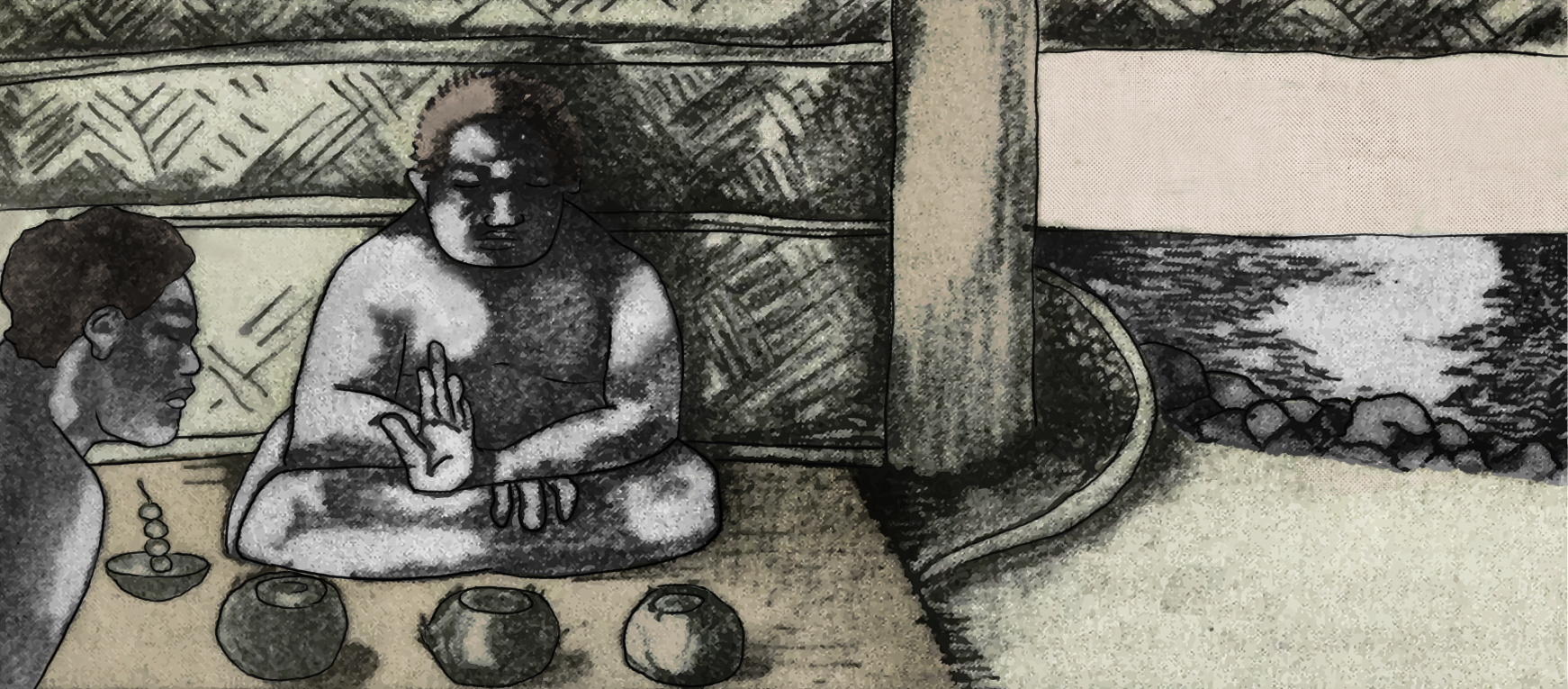
‘Ua finagalo nei Mālietoa Sagaga ‘ia va’ai lelei e Fata ma Maulolo, tulāfale sili o Tuisāmau, ‘ia sili ona fa’aaloalogia ‘o la i lo le Gato ai- tele. Sā tete’e e Fata ma Maulolo lea finagalo, ma na mafua ai loa ona vatau o Malie ma Afega.
‘Ina ‘ia tā’otogalelei ma fa’amuta lea vātau, sā fa’ailoa atu e Gato’a itele ‘i ā Tupa’i sā iai pea i Leulumoega i na lava onapo. Sā tali atu Tu- pa’i ‘ua lelei, ‘o le’ā se’i logo ‘i ā Nāfanua (Se i muamua ona logo atu o Nafanua i Salāfai).
Sā malaga loa Tupa’i e talanoa le jatā’upu ‘i ā Nāfanua. Sā tali atu mo aso e lima, ‘ina ‘ia Nāfanua, “0 ia ma tau le taua, „’ae ia fa atali mo sāunia Taonumaipe’a ma ana ‘au.inn atu ‘i le Tuisāmau ‘ia nofo sāuni mo le Sā toe fo i mai Tupa i ma a Māfanua ‘ae, ‘o 1e ao ‘o le’S tāofia, iso lona lima. ‘0 le’ā fasoas?^\ mx,Si le’malae o Tanumafili i Tuanā’i, na ‘o Tupa’i ‘o le’ā na fa’^aeina 1e malo Sisifo 0 Afega a e fai.o se nofoaga pe 5 minute o se savaliga nālō i le Tuisāmau.
Ina ‘ua 1ogo Mālietoa ma ‘Auimataai ‘ua ‘au Nāfanua ‘i 1p itu n Afeaa, ‘ā lātou tau pea lava le taua, ‘ae ‘ua fa ‘alotolotolua, taluai ua mautinoa lelei lava ‘o le manumālō, ‘e i le itū o le atua fafine. Na ‘o ni nai aso na tau ai le taua, ‘ae lafoia loa Mālietoa, ma ‘o vaegā’au a Tonumaipe’a, sa la- tou vete ma fa’atauma’oi le ‘au faia’ina (to’ilalo).
‘0 lea sā fa’avae ai e Tupa’i le mālō i Tanumafili ma nofo ai pea e talia le lāuga a Tuisāmau (’e talia le tanoa a Tuisāmau). Muamua i lea taua, ‘o le igoa “Laumua” sā tu’uina ‘i ā Mālietoa, ‘a e maise Mālietoa ‘ese’ese na soso’o ane ai (na fa’asino ‘i ā Mālietoa Sāvea ma ona suli). ‘Ae ‘ina ‘ua mavae le taua, sā suia lenei igoa mamalu “Laumua” ma tu’uina ‘i ā Afega ma ona tulāfale sili, ‘o Fata ma Maulolo. ‘Ua ‘avea ai fo’i Afena ma Laumua o ie Tuamāsaga, peita’i ‘o le suafa Maualuga ‘o Gato’aitele ‘ua ’avea fo’i e Nāfanua.
‘E ui lava ‘o lenei taua sā tupu e tusa ma le 400 tausaga taluai (1500 AD), ‘o aiaiga na maua ai, ‘o lo ‘o taualoa pea i ona Fa’alupega, ‘o Tuana’i = Afega: – “Tulouna a lau fetalaiga Tupa’i, na ‘e leo i Tanumafili.”

Malietoa Sagagaimuli, the son of Malietoa Falefatu, watched, and not without anxiety the growing influence of Tamalelagi. He had not approved of this marriage with a daughter of Folasaitu, for he well knew that in case of war he could not rely on the help of Faleata to the same extent as before.
As, however, all the great titles of Upolu were in the custody of Nafanua, he thought that the opportunity had come to make himself the king of Samoa. If Nafanua kept aloof, he had the best chance to win, the more so as not only his Tuamasaga, but also Manono (aiga i le tai) and part of Savai’i, especially the Fa’asalele’aga district, would certainly fight on his side. These thoughts were now uppermost in his mind and he was only waiting for a plausible reason or excuse to start hostilities.
One day, when Tamalelagi was taking a bath on the sandy beach of Tufulele which at that time belonged to Tuamasaga, some orators of Saleimoa, who happened to come that way insulted him grievously.
Hearing of this, the A’ana people wanted to destroy Saleimoa and lay some of their enemies’ heads at the feet of Tamalelagi as a sign that the insult had been avenged.
Tamalelagi, however, restrained them, saying that his hour had not come yet. He then discussed the incident with his advisor and counselor Alipia and some others of the Falefitu. They all well knew that Malietoa was at the bottom of the trouble, nor did they have any doubts about his motive.
Alipia counselled to attack Malietoa without any delay. This would force him to recognize the authority of A’ana and make him return all the lands and villages robbed from them by his predecessors.
Lemana and others spoke to the same effect. They all agreed that war, and war only, would settle their differences once and for all. Win they would, for there was little doubt that Atua, the old ally of A’ana, would fight on their side, whilst most of the Safata and Faleata people would remain neutral or be divided.
It was furthermore decided not to apply to Nafanua for assistance. However, Alipia and Lemana should consult the Fe’e (octopus) as to the outcome of the war. The Fono (Assembly of chiefs) was then dismissed.
Late that night, the Tulafale-Ali’i went back into the Faletele (meeting house). They let down the plaited shutters (pola) all around the house, except the one on the sea side, to serve as an entrance for the Fe’e. Alipia sat down in one corner (tala) of the house while Lemana did likewise in the opposite tala. Another talking chief then brought three small coconuts, whose tops had been carefully loosened. He gave one to each of the tulafale-ali’i and placed the third one in the center of the house. After this was done he departed, leaving Alipia and Lemana to await the arrival of the Fe’e.
What happened that dark night in the Faletele, no one knows to a certainty, but the following morning Alipia emerged and announced solemnly that the Fe’e the octopus, their venerated war god, was entirely in their favour and their victory was assured. They would go to war.
Comments are closed here.